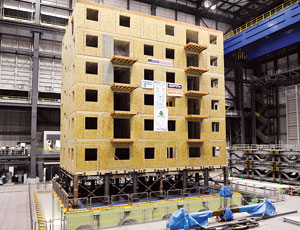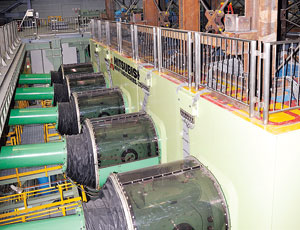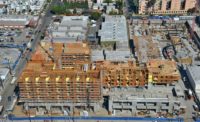A 40-second test in Japan on the world’s largest shake table demonstrated for the first time that wood-framed mid-rise buildings can be built to withstand major earthquakes, say researchers. The simulation of a magnitude-7.5 quake on a six-story residential building caps a $1.4-million research project that is elevating performance-based seismic design of wood frames. The work is expected to result in new standards for mid-rise wood buildings, which rarely are allowed in quake zones.


During the July 14 test, the building, 40 ft x 60 ft in plan, performed “exactly as it should have,” with almost no damage, says John van de Lindt, principal investigator for NEESWood, which is a project of the George E. Brown Jr. Network for Earthquake Engineering Simulation.
The four-year investigation funded by the National Science Foundation is a collaboration of Colorado State University, Fort Collins, (where van de Lindt is a professor of structural engineering) and four other NEESWood schools. The goal is to “safely increase the height of wood-frame construction” in seismic zones to six stories while incorporating technology that minimizes seismic damage.
The tests in Miki City, Japan, validate the research methodology, called direct displacement design, say researchers. It is a way to analyze wood structures for tailored quake performance using a simpler form of nonlinear time-history analysis, developed by NEESWood. “We put the material where it is needed to get a uniform response over the structure,” says van de Lindt. Called SAPWood, the free analysis software is available for downloading at software.
NEESWood is pushing wood-frame residential buildings because, compared with concrete, they are about 30% less expensive, take less time to build and are more sustainable. The peformance-based design approach, if it becomes a typical option to meet code, would cost 5% to 7% more than an equivalent wood building that follows the prescriptive code, van de Lindt adds.
The research consisted of a series of tests on wood frames in the U.S. and three tests in Japan on the 14,000-sq-ft frame on June 6, 30 and July 14. The June 30 test was on a seven-story building that included six stories of wood framing on a ground-floor special moment frame in steel. It simulated a slighter weaker quake than the July 14 test.
The hybrid frame also performed “very well,” says Steve Pryor, a structural engineer for Simpson Strong-Tie, a collaborator on the tests that makes structural steel connectors, fasteners, anchors and lateral-force resisting systems for all types of framing materials. The steel special moment frame, a patent-pending system that connects to wood framing above, is not yet on the market. “This was the proof of concept,” says Pryor.
Simpson’s proprietary products were used throughout the test building. All Miki tests used the same structure. For the final test, the steel frame, intended for a retail space, was “locked down” with heavy bracing to effectively render it an extension of the shake table, leaving the wood frame as the test specimen.
Van de Lindt expects several years are needed to develop standards that reflect the researchers’ findings. “We’ve learned you can build a six-story wood building that performs well in an earthquake,” he says. After that, it simply becomes an issue of fire safety and durability, he adds.



Post a comment to this article
Report Abusive Comment